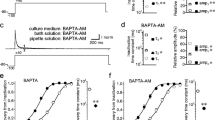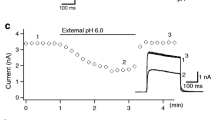Abstract
Strong inward rectifier K+ channels (Kir2.1) mediate background K+ currents primarily responsible for maintenance of resting membrane potential. Multiple types of cells exhibit two levels of resting membrane potential. Kir2.1 and K2P1 currents counterbalance, partially accounting for the phenomenon of human cardiomyocytes in subphysiological extracellular K+ concentrations or pathological hypokalemic conditions. The mechanism of how Kir2.1 channels contribute to the two levels of resting membrane potential in different types of cells is not well understood. Here we test the hypothesis that Kir2.1 channels set two levels of resting membrane potential with inward rectification. Under hypokalemic conditions, Kir2.1 currents counterbalance HCN2 or HCN4 cation currents in CHO cells that heterologously express both channels, generating N-shaped current-voltage relationships that cross the voltage axis three times and reconstituting two levels of resting membrane potential. Blockade of HCN channels eliminated the phenomenon in K2P1-deficient Kir2.1-expressing human cardiomyocytes derived from induced pluripotent stem cells or CHO cells expressing both Kir2.1 and HCN2 channels. Weakly inward rectifier Kir4.1 or inward rectification-deficient Kir2.1•E224G mutant channels do not set such two levels of resting membrane potential when co-expressed with HCN2 channels in CHO cells or when overexpressed in human cardiomyocytes derived from induced pluripotent stem cells. These findings demonstrate a common mechanism that Kir2.1 channels set two levels of resting membrane potential with inward rectification by balancing inward currents through different cation channels such as hyperpolarization-activated HCN channels or hypokalemia-induced K2P1 leak channels.






Similar content being viewed by others
Abbreviations
- HCN:
-
Hyperpolarization-activated cyclic nucleotide-gated cation channel
- iPSC:
-
Induced pluripotent stem cells
- I-V :
-
Current-voltage
- Kir2.1:
-
Inward rectifier K+ channel subfamily 2 isoform 1
- K2P1:
-
Two pore-domain K+ channel isoform 1
References
Anumonwo JM, Lopatin AN (2010) Cardiac strong inward rectifier potassium channels. J Mol Cell Cardiol 48(1):45–54. https://doi.org/10.1016/j.yjmcc.2009.08.013
Biel M, Wahl-Schott C, Michalakis S, Zong X (2009) Hyperpolarization-activated cation channels: from genes to function. Physiol Rev 89(3):847–885. https://doi.org/10.1152/physrev.00029.2008
Cannon SC (2015) Channelopathies of skeletal muscle excitability. Compr Physiol 5(2):761–790. https://doi.org/10.1002/cphy.c140062
Christe G (1982) Effects of low [K+]o on the electrical activity of human cardiac ventricular and Purkinje cells. Cardiovasc Res 17:243–250
Cui J (2016) Voltage-dependent gating: novel insights from KCNQ1 channels. Biophys J 110(1):14–25. https://doi.org/10.1016/j.bpj.2015.11.023
Doss MX, Di Diego JM, Goodrow RJ, Wu Y, Cordeiro JM, Nesterenko VV, Barajas-Martinez H, Hu D, Urrutia J, Desai M, Treat JA, Sachinidis A, Antzelevitch C (2012) Maximum diastolic potential of human induced pluripotent stem cell-derived cardiomyocytes depends critically on I(Kr). PLoS One 7:e40288. https://doi.org/10.1371/journal.pone.0040288
Ellis D (1977) The effects of external cations and ouabain on the intracellular sodium activity of sheep heart Purkinje fibres. J Physiol 273(1):211–240. https://doi.org/10.1113/jphysiol.1977.sp012090
Gadsby DC, Cranefield PF (1977) Two levels of resting potential in cardiac Purkinje fibers. J Gen Physiol 70(6):725–746. https://doi.org/10.1085/jgp.70.6.725
Gallaher J, Bier M, van Heukelom JS (2010) First order phase transition and hysteresis in a cell’s maintenance of the membrane potential—an essential role for the inward potassium rectifiers. Bio Systems 101(3):149–155. https://doi.org/10.1016/j.biosystems.2010.05.007
Gallin EK (1981) Voltage clamp studies in macrophages from mouse spleen cultures. Science 214(4519):458–460. https://doi.org/10.1126/science.7291986
Gallin EK, Livengood DR (1981) Inward rectification in mouse macrophages: evidence for a negative resistance region. Am J Phys 241:C9–17
Geukes Foppen RJ, van Mil HG, van Heukelom JS (2002) Effects of chloride transport on bistable behaviour of the membrane potential in mouse skeletal muscle. J Physiol 542(1):181–191. https://doi.org/10.1113/jphysiol.2001.013298
Herrmann S, Hofmann F, Stieber J, Ludwig A (2012) HCN Channels in the heart: lessons from mouse mutants. Br J Pharmacol 166(2):501–509. https://doi.org/10.1111/j.1476-5381.2011.01798.x
Hibino H, Inanobe A, Furutani K, Murakami S, Findlay I, Kurachi Y (2010) Inwardly rectifying potassium channels: their structure, function, and physiological roles. Physiol Rev 90(1):291–366. https://doi.org/10.1152/physrev.00021.2009
Hoekstra M, Mummery CL, Wilde AA, Bezzina CR, Verkerk AO (2012) Induced pluripotent stem cell derived cardiomyocytes as models for cardiac arrhythmias. Front Physiol 3:346
Jurkat-Rott K, Weber MA, Fauler M, Guo XH, Holzherr BD, Paczulla A, Nordsborg N, Joechle W, Lehmann-Horn F (2009) K+-dependent paradoxical membrane depolarization and Na+ overload, major and reversible contributors to weakness by ion channel leaks. Proc Natl Acad Sci U S A 106(10):4036–4041. https://doi.org/10.1073/pnas.0811277106
Kubo Y, Murata Y (2001) Control of rectification and permeation by two distinct sites after the second transmembrane region in Kir2.1 K+ channel. J Physiol 531(3):645–660. https://doi.org/10.1111/j.1469-7793.2001.0645h.x
Lee CO, Fozzard HA (1979) Membrane permeability during low potassium depolarization in sheep cardiac Purkinje fibers. Am J Phys 237:C156–C165
Lieu DK, Fu JD, Chiamvimonvat N, Tung KC, McNerney GP, Huser T, Keller G, Kong CW, Li RA (2013) Mechanism-based facilitated maturation of human pluripotent stem cell-derived cardiomyocytes. Circ Arrhythm Electrophysiol 6(1):191–201. https://doi.org/10.1161/CIRCEP.111.973420
Lopatin AN, Nichols CG (2001) Inward rectifiers in the heart: an update on I(K1). J Mol Cell Cardiol 33(4):625–638. https://doi.org/10.1006/jmcc.2001.1344
Ma J, Guo L, Fiene SJ, Anson BD, Thomson JA, Kamp TJ, Kolaja KL, Swanson BJ, January CT (2011) High purity human-induced pluripotent stem cell-derived cardiomyocytes: electrophysiological properties of action potentials and ionic currents. Am J Physiol Heart Circ Physiol 301(5):H2006–H2017. https://doi.org/10.1152/ajpheart.00694.2011
Ma L, Zhang X, Chen H (2011) TWIK-1 two-pore domain potassium channels change ion selectivity and conduct inward leak sodium currents in hypokalemia. Sci Signal 4:ra37
McCullough JR, Chua WT, Rasmussen HH, Ten Eick RE, Singer DH (1990) Two stable levels of diastolic potential at physiological K+ concentrations in human ventricular myocardial cells. Circ Res 66(1):191–201. https://doi.org/10.1161/01.RES.66.1.191
Miura DS, Hoffman BF, Rosen MR (1977) The effect of extracellular potassium on the intracellular potassium ion activity and transmembrane potentials of beating canine cardiac Purkinje fibers. J Gen Physiol 69(4):463–474. https://doi.org/10.1085/jgp.69.4.463
Proenza C, Yellen G (2006) Distinct populations of HCN pacemaker channels produce voltage-dependent and voltage-independent currents. J Gen Physiol 127(2):183–190. https://doi.org/10.1085/jgp.200509389
Rastegar A, Soleimani M (2001) Hypokalaemia and hyperkalaemia. Postgrad Med J 77(914):759–764. https://doi.org/10.1136/pmj.77.914.759
Ravesloot JH, Ypey DL, Vrijheid-Lammers T, Nijweide PJ (1989) Voltage-activated K+ conductances in freshly isolated embryonic chicken osteoclasts. Proc Natl Acad Sci U S A 86(17):6821–6825. https://doi.org/10.1073/pnas.86.17.6821
Roubille F, Tardif JC (2013) New therapeutic targets in cardiology: heart failure and arrhythmia: HCN channels. Circulation 127(19):1986–1996. https://doi.org/10.1161/CIRCULATIONAHA.112.000145
Shah AK, Cohen IS, Datyner NB (1987) Background K+ current in isolated canine cardiac Purkinje myocytes. Biophys J 52(4):519–525. https://doi.org/10.1016/S0006-3495(87)83241-1
Sheu SS, Korth M, Lathrop DA, Fozzard HA (1980) Intra- and extracellular K+ and Na+ activities and resting membrane potential in sheep cardiac purkinje strands. Circ Res 47(5):692–700. https://doi.org/10.1161/01.RES.47.5.692
Siegenbeek van Heukelom J (1991) Role of the anomalous rectifier in determining membrane potentials of mouse muscle fibres at low extracellular K+. J Physiol 434(1):549–560. https://doi.org/10.1113/jphysiol.1991.sp018485
Sims SM, Dixon SJ (1989) Inwardly rectifying K+ current in osteoclasts. Am J Phys 256:C1277–C1282
Struyk AF, Cannon SC (2008) Paradoxical depolarization of BA2+-treated muscle exposed to low extracellular K+: insights into resting potential abnormalities in hypokalemic paralysis. Muscle Nerve 37(3):326–337. https://doi.org/10.1002/mus.20928
Ten Eick RE, Singer DH (1979) Electrophysiological properties of diseased human atrium. I. Low diastolic potential and altered cellular response to potassium. Circ Res 44(4):545–557. https://doi.org/10.1161/01.RES.44.4.545
Wiggins JR, Cranefield PF (1976) Two levels of resting potential in canine cardiac Purkinje fibers exposed to sodium-free solutions. Circ Res 39(4):466–474. https://doi.org/10.1161/01.RES.39.4.466
Yang J, Jan YN, Jan LY (1995) Control of rectification and permeation by residues in two distinct domains in an inward rectifier K+ channel. Neuron 14(5):1047–1054. https://doi.org/10.1016/0896-6273(95)90343-7
Zaza A (2009) Serum potassium and arrhythmias. Europace 11(4):421–422. https://doi.org/10.1093/europace/eup005
Zhou M, Xu G, Xie M, Zhang X, Schools GP, Ma L, Kimelberg HK, Chen H (2009) TWIK-1 and TREK-1 are potassium channels contributing significantly to astrocyte passive conductance in rat hippocampal slices. J Neurosci 29(26):8551–8564. https://doi.org/10.1523/JNEUROSCI.5784-08.2009
Zuo D, Chen K, Zhou M, Liu Z, Chen H (2017) Kir2.1 and K2P1 channels reconstitute two levels of resting membrane potential in cardiomyocytes. J Physiol 595(15):5129–5142. https://doi.org/10.1113/JP274268
Acknowledgements
We thank Steven A. Siegelbaum, Juliane Stieber, and Catherine Proenza for providing HCN plasmids and Stephen J. Tucker for providing rat Kir4.1 plasmids.
Funding
This work was supported by the National Institute of General Medical Sciences, NIH (R01GM102943) and the National Natural Science Foundation of China (81370296, 81370297, and 81570303).
Author information
Authors and Affiliations
Contributions
HC, DZ, KC, and ZL designed the research; HC, DZ, and KC analyzed data; DZ and KC performed the research; and HC, DZ, and KC wrote the paper.
Corresponding author
Ethics declarations
Conflict of interest
The authors declare that they have no competing interests.
Rights and permissions
About this article
Cite this article
Chen, K., Zuo, D., Liu, Z. et al. Kir2.1 channels set two levels of resting membrane potential with inward rectification. Pflugers Arch - Eur J Physiol 470, 599–611 (2018). https://doi.org/10.1007/s00424-017-2099-3
Received:
Revised:
Accepted:
Published:
Issue Date:
DOI: https://doi.org/10.1007/s00424-017-2099-3




